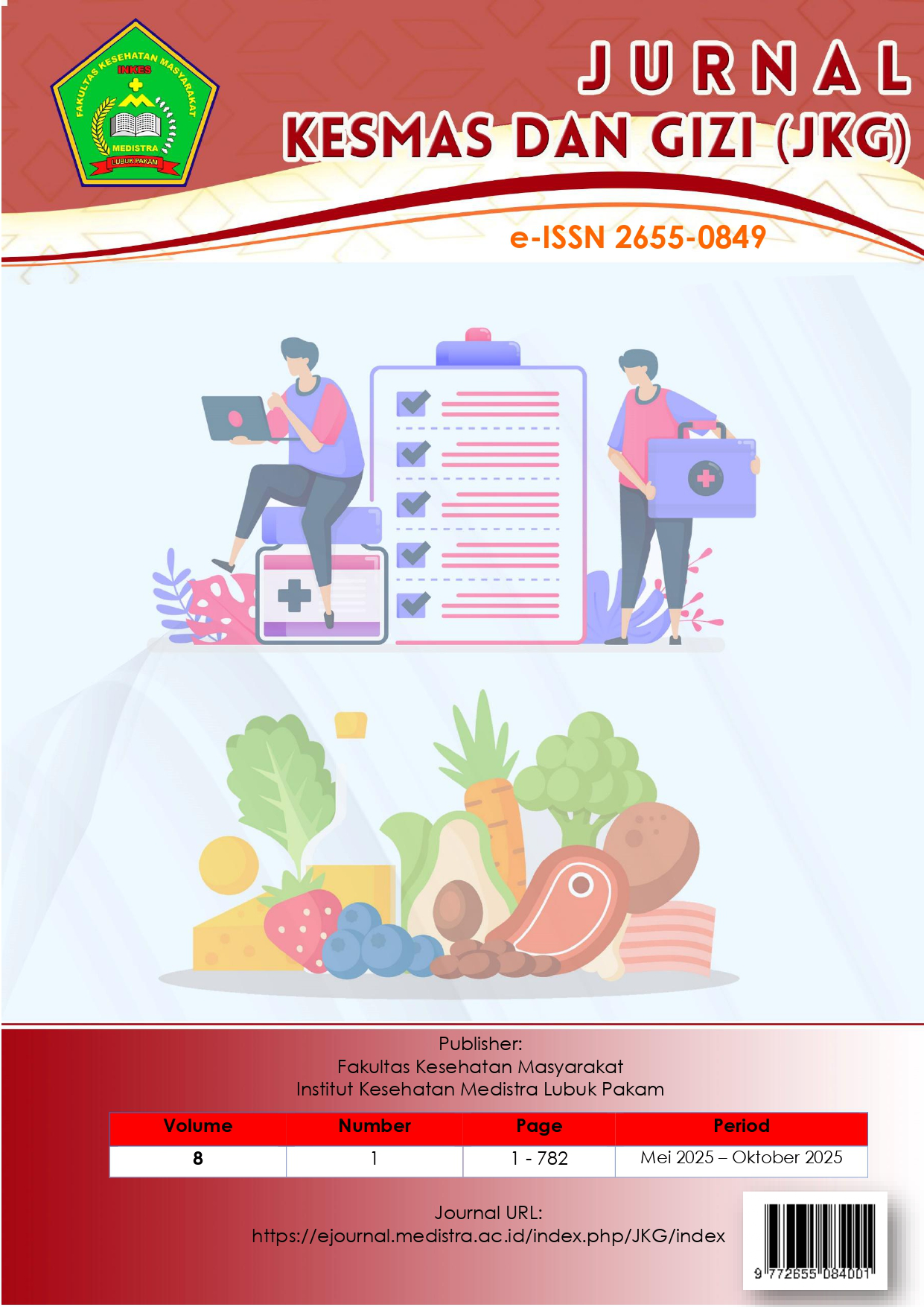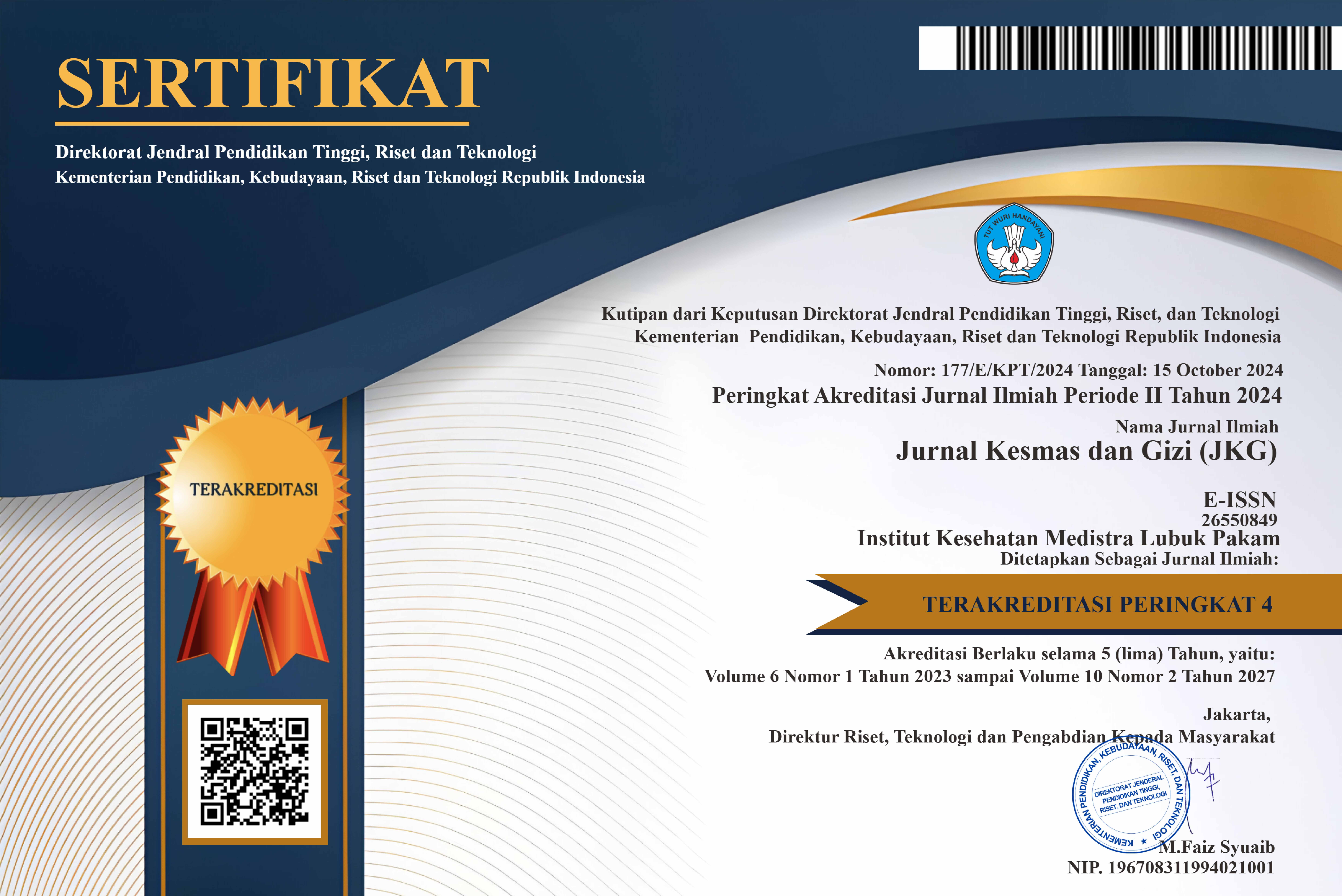Relationship of Stress Factors and Nutritional Status With Random Blood Glucose Levels In Pre-Elderly Type II Diabetes Patients at Grandmed Hospital Lubuk Pakam
DOI:
https://doi.org/10.35451/eeh3hj34Keywords:
Diabetes Melitus Tipe II, Pra-Lansia, Kadar Glukosa Darah Acak, Status Gizi, Faktor StresAbstract
Type II diabetes mellitus is one of the chronic metabolic diseases that remains a major cause of morbidity and mortality worldwide. Its steadily increasing prevalence each year poses significant challenges to public health systems. This study aims to analyze the relationship between stress levels and nutritional status with random blood glucose levels among pre-elderly patients with type II diabetes mellitus who were hospitalized at Grandmed Hospital, Lubuk Pakam. This quantitative study employed a correlational design. A total of 53 respondents were selected using purposive sampling based on inclusion criteria. Stress levels were measured using the Diabetes Distress Scale (DDS) questionnaire, while nutritional status was determined using the Body Mass Index (BMI). Random blood glucose data were obtained from laboratory test results and analyzed using the Spearman correlation test with a significance level of p<0.05 The analysis revealed a significant relationship between stress factors and random blood glucose levels (p=0.035), as well as between nutritional status and random blood glucose levels (p=0.026). Patients experiencing higher stress levels and excessive nutritional status tended to have higher random blood glucose levels compared to other respondents. Stress levels and nutritional status are significantly associated with random blood glucose levels among pre-elderly patients with type II diabetes mellitus. Therefore, effective stress management and proper nutritional regulation should be integral components of blood glucose control strategies to prevent long-term complications in older individuals
Downloads
References
[1] A. Ali Redhadkk., “Wawasan baru tentang potensi anti-obesitas dari pohon ajaib, Moringa oleifera: Sebuah tinjauan sistematis,” J. Funct. Foods, vol. 84, hlm. 104600, 2021, doi: 10.1016/j.jff.2021.104600.
[2] Reed J, Bain S, Kanamarlapudi V. Tinjauan Tren Terkini Epidemiologi, Etiologi, Patogenesis, Penanganan, dan Perspektif Masa Depan Diabetes Tipe 2. Diabetes Metab Syndr Obes. 10 Agustus 2021;14:3567-3602. doi: 10.2147/DMSO.S319895. PMID: 34413662; PMC.
[3] “IDF (2021).”.
[4] FU Haqdkk., “Tinjauan Komparatif Obat yang Digunakan pada Diabetes Melitus—Baru dan Lama,” J. Diabetes Melitus, vol. 11, no. 04, hlm. 115–131, 2021, doi: 10.4236/jdm.2021.114009.
[5] N. Apriyan, A. Kridawati, dan TBW Rahardjo, "Hubungan Diabetes Melitus Tipe 2 dengan Kualitas Hidup pada Pra Lansia dan Lansia di Kelompok Prolanis,"J. Untuk Masyarakat yang Sehat, vol. 4, no. 2, hlm. 144–158, 2020, doi: 10.52643/jukmas.v4i2.1028.
[6] R. Panjaitan, R. Irwanto, A. Boffil Cholilullah, dan S. Angraini, “Hubungan Pola Makan dengan Status Gizi Pasien Rawat Jalan Diabetes Melitus Tipe 2 di Wilayah Kerja RS Grandmed Lubuk Pakam,”Jurnal Kesehatan Masyarakat dan Gizi, vol. 3, no. 2, hlm. 168–171, 2021, doi: 10.35451/jkg.v3i2.660.
[7] CAA Purwandari, B. Wirjatmadi, dan T. Mahmudiono, “Faktor Risiko Komplikasi Kronis Diabetes Mellitus Tipe 2 pada Pra Lansia,”Amerta Nutr., jilid. 6, tidak. 3, hal.262–271, 2022, doi: 10.20473/amnt.v6i3.2022.262-271.
[8] TR Novita dan Y. Efrarianti, “Faktor-Faktor yang Berhubungan dengan Diabetes Melitus pada Usia Pra-Lansia (45-59 Tahun) di Wilayah Kerja Puskesmas Rantau Keloyang,”J. Kesehatan. Teknologi Med., vol. 9, no. 1, hal. 204, 2023, doi: 10.33143/jhtm.v9i1.2802.
[9] F. Milita, S. Handayani, dan B. Setiaji, “Kejadian Diabetes Mellitus Tipe II pada Lansia di Indonesia (Analisis Riskesdas 2018),”J. Kedokteran dan Kesehatan., vol. 17, no. 1, hal. 9, 2021.
[10] R. Irwanto, A. Febriana Siregar, K. Ate Ginting, dan F. Ndruru, “Faktor-Faktor Yang Berhubungan Dengan Diabetes Melitus Tipe 2 Pada Pasien Di RS Grandmed Lubuk Pakam,”Jurnal Kesehatan Masyarakat dan Gizi, vol. 3, no. 2, hlm. 172–176, 2021, doi: 10.35451/jkg.v3i2.664.
[11] L. Paradisa, AS Syagata, dan FR Fauzia, “Status Gizi Berkaitan dengan Kadar Glukosa Darah Puasa pada Penderita DM Tipe II di Wilayah Kerja Puskesmas Mlati II,”J. Ilmu Kesehatan., vol. 13, no. 1, hlm. 21–32, 2025.
[12] G. Safari, S. Salvia, dan D. Rizki Iraki Lukman, "Korelasi Tingkat Stres terhadap Kadar Gula Darah pada Penderita Diabetes Melitus,"Sembuh. J., vol. 11, no. 2, hlm. 61–70, 2022, doi: 10.55222/healthyjournal.v11i2.1091.
[13] L. Ludiana, U. Hasanah, SA Sari, NL Fitri, dan S. Nurhayati, “Hubungan Faktor Psikologis (Stres dan Depresi) dengan Kadar Gula Darah pada Penderita Diabetes Melitus Tipe 2,”J. Wacana Kesehatan., jilid. 7, tidak. 2, hal. 61, 2022, doi: 10.52822/jwk.v7i2.413.
[14] Ni Luh Putu Dewi Pridani, Putu Asih Primatanti, dan Sri Ratna Dewi, "Hubungan Tingkat Stres dengan Kadar Glukosa Darah Puasa pada Pasien Diabetes Tipe 2 di RSUD Sanjiwani, Gianyar,"Jurnal Kedokteran Aesculapius, jilid. 4, tidak. 2, hal.234–238, 2024, doi: 10.22225/amj.4.2.2024.234-238.
[15] D. Nalole, Nuryani, Maesarah, dan D. Adam, “Deskripsi Pengetahuan, Status Gizi, Konsumsi Zat Gizi dan Kepatuhan Diet pada Pasien Diabetes Melitus,”Gorontalo J. Nutr. Diet., vol. 1, no. 2, hal. 75, 2021.
[16] F. Lainsamputty, N. Sampouw, DD Tampa'i, dan M. Fahrul, “Hubungan Antara Dimensi Gaya Hidup dan Stres pada Pasien Diabetes Melitus Tipe 2,”Jurnal Ilmiah Keperawatan, vol. 8, no. 2, hlm. 373–382, 2022, doi: 10.33023/jikep.v8i2.1148.
[17] ABP Enarga, POD Megasari, D. Novitasari, dan AR Pranadipta, "Pengaruh Pemberian Edukasi terhadap Tingkat Pengetahuan, Manajemen Diri, dan Kadar Glukosa Darah Penderita DMT2,"Jenius Farmasi, vol. 2, no. 3, hlm. 145–162, 2023, doi: 10.56359/pharmgen.v2i3.288.
[18] "Organisasi Kesehatan Dunia. (2021). Laporan global tentang diabetes. Jenewa: Organisasi Kesehatan Dunia. https://www.who.int/publications/i/item/9789241565257".
[19] M. Ristiyowati, FAA Motuho Mendrofa, SP Lestari, dan TI Pujiyanto, “Efektivitas Program Mitra Lansia terhadap Kadar Glukosa Darah pada Lansia dengan Diabetes Melitus Tipe II,”Jurnal Ilmu Keperawatan dan Kebidanan, jilid. 15, tidak. 1, hal.149–155, 2024, doi: 10.26751/jikk.v15i1.2220.
Downloads
Published
Issue
Section
License
Copyright (c) 2025 edarni zebua, Riska Rani Duita Simarmata, Salmi Angraini, Dian Novita

This work is licensed under a Creative Commons Attribution 4.0 International License.
Copyright in each article is the property of the Author.


























